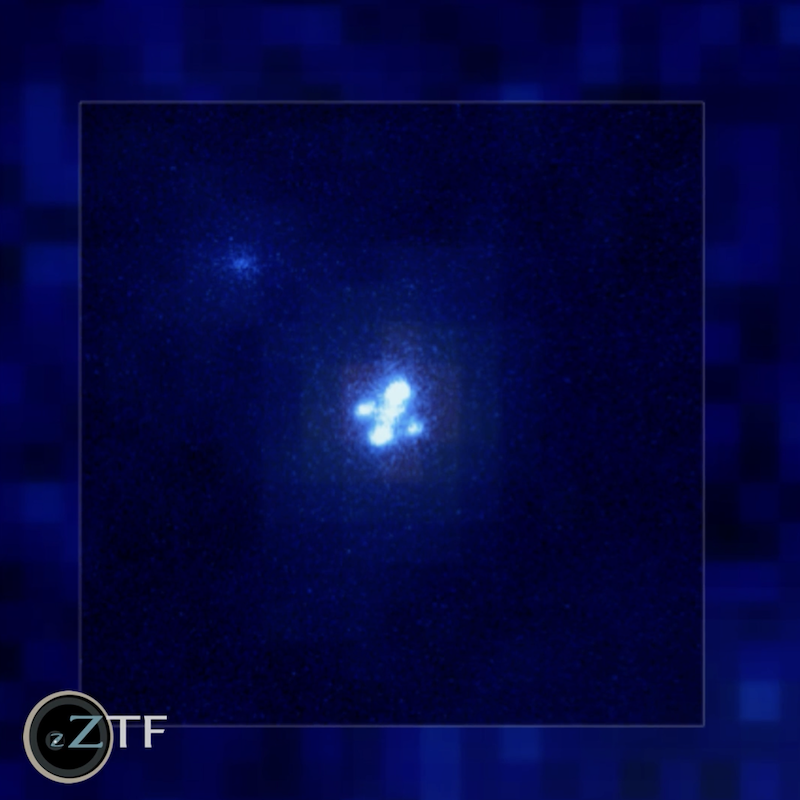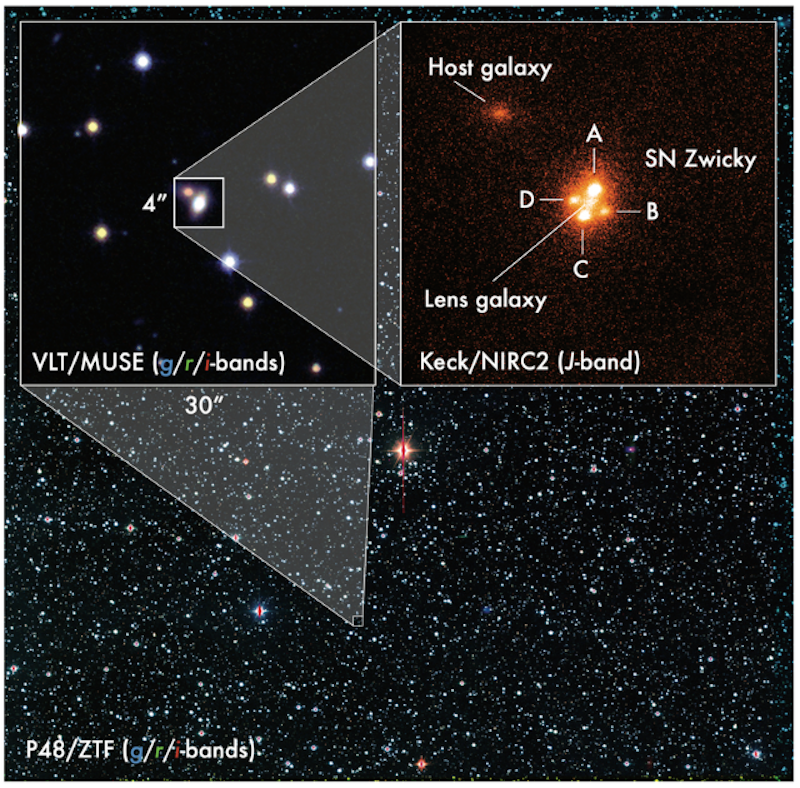
On June 15, 2023, an international team of astronomers released an unusual new image of a very distant supernova, a star that increased suddenly and dramatically in brightness. This supernova is 4 billion light-years away. And it appears as four supernovae in images. Why? The reason is an intervening galaxy, only about 2.5 billion light-years distant. The galaxy’s mass has warped the supernova’s light before the light had a chance to reach us.
This is the phenomenon of gravitational lensing, first described in the equations of Albert Einstein early in the 20th century. As Einstein said, mass causes space to curve. So the light of supernova SN Zwicky – as it’s called – must curve on its journey around the galaxy. In this peculiar situation, light from more-distant supernova curves so that we see four supernovae.
Ariel Goobar from the Oskar Klein Centre at Stockholm University in Sweden led the team that captured the new image. The astronomers used multiple telescopes to observe SN Zwicky.
The researchers published the image and other peer-reviewed details about the observations in Nature Astronomy on June 12, 2023.
A lensed supernova is a rare phenomenon
Detecting these kinds of lensed supernovae is not easy, as the paper describes:
Detecting gravitationally lensed supernovae is among the biggest challenges in astronomy. It involves a combination of two very rare phenomena: catching the transient signal of a stellar explosion in a distant galaxy and observing it through a nearly perfectly aligned foreground galaxy that deflects light toward the observer.
SN Zwicky isn’t the first such lensed supernova seen, but it is the smallest. Goobar said:
SN Zwicky is the smallest resolved gravitational lens system found with optical telescopes. iPTF16geu was a wider system but had larger magnification.
Astronomers have also observed other lensed objects, such as quasars, since 1919. So far, those have outnumbered the lensed supernova seen, making SN Zwicky fairly rare.

Single supernova appears as 4
The supernova is what’s called a Type Ia. Its light arrived at Earth on August 21, 2022, when the Zwicky Transient Facility at Palomar Observatory picked it up.
Next, the team observed the supernova with the W. M. Keck Observatory on Maunakea, Hawaii, and the Very Large Telescope in Chile. The Hubble Space Telescope, Hobby-Eberly Telescope, Liverpool Telescope and Nordic Optical Telescope also observed the supernova.
The researchers wanted to test the hypothesis that the galaxy would create a lensing effect on the supernova, causing it to appear as four supernovae instead of just one. And the test worked!
Goobar said:
With ZTF, we have the unique ability to catch and classify supernovae … We noticed that SN Zwicky was brighter than it should have been given its distance to us and quickly realized that we were seeing a very rare phenomenon called strong gravitational lensing. Such lensed objects can help us to uniquely probe the amount and distribution of matter at the inner core of galaxies.
It was a stunning result, as astronomer Christoffer Fremling at the Caltech Optical Observatory noted:
I was observing that night and was absolutely stunned when I saw the lensed image of SN Zwicky. We catch and classify thousands of transients with the Bright Transient Survey, and that gives us a unique ability to find very rare phenomena such as SN Zwicky.
The foreground galaxy acted as a gravitational lens, just as predicted. It not only magnified the background supernova, it also created multiple light patches from it, in different positions. The result was that the one supernova now appeared to be four, close to each other in the sky.
New clues about the universe
The unique four-way split image provides astronomers with clues about both the supernova and the foreground galaxy. This, in turn, can help astronomers learn more about the inner cores of galaxies, dark matter and the expansion of the universe. Joel Johansson, a postdoctoral fellow at Stockholm University and a co-author of the study, said:
The extreme magnification of SN Zwicky gives us an unprecedented chance to study the properties of distant Type Ia supernova explosions, which we need when we use them to explore the nature of dark energy.
Goobar added:
The discovery of SN Zwicky not only showcases the remarkable capabilities of modern astronomical instruments but also represents a significant step forward in our quest to understand the fundamental forces shaping our universe.
What are missing components needed to model the expansion history of the universe? What is the dark matter that makes up the vast majority of the mass in galaxies? As we discover more ‘SN Zwickys’ with ZTF and the upcoming Vera Rubin Observatory, we will have another tool to chip away at the mysteries of the universe and find answers.
How does gravitational lensing work?
The renowned physicist Albert Einstein first predicted gravitational lensing more than a century ago. How does it work? When light from a distant cosmic object encounters another dense object as it travels toward us, the closer dense object bends and distorts the light, like a lens. The effect is like a giant cosmic magnifying glass. The effect varies depending on the density of the closer object and the distance between it and us.
When the lensing effect is strong enough, the bent light distorts so much that it splits into multiple copies of itself. The effect is that when we look at the original object – like the supernova – there appear to be more than one object, almost like carbon copies or clones. Bizarre!
Bottom line: Astronomers have released a bizarre new image of a supernova. Gravitational lensing from a galaxy in the foreground causes the single supernova to look like four.
The post Single supernova looks like 4. Why? first appeared on EarthSky.
from EarthSky https://ift.tt/fZvKMXP

On June 15, 2023, an international team of astronomers released an unusual new image of a very distant supernova, a star that increased suddenly and dramatically in brightness. This supernova is 4 billion light-years away. And it appears as four supernovae in images. Why? The reason is an intervening galaxy, only about 2.5 billion light-years distant. The galaxy’s mass has warped the supernova’s light before the light had a chance to reach us.
This is the phenomenon of gravitational lensing, first described in the equations of Albert Einstein early in the 20th century. As Einstein said, mass causes space to curve. So the light of supernova SN Zwicky – as it’s called – must curve on its journey around the galaxy. In this peculiar situation, light from more-distant supernova curves so that we see four supernovae.
Ariel Goobar from the Oskar Klein Centre at Stockholm University in Sweden led the team that captured the new image. The astronomers used multiple telescopes to observe SN Zwicky.
The researchers published the image and other peer-reviewed details about the observations in Nature Astronomy on June 12, 2023.
A lensed supernova is a rare phenomenon
Detecting these kinds of lensed supernovae is not easy, as the paper describes:
Detecting gravitationally lensed supernovae is among the biggest challenges in astronomy. It involves a combination of two very rare phenomena: catching the transient signal of a stellar explosion in a distant galaxy and observing it through a nearly perfectly aligned foreground galaxy that deflects light toward the observer.
SN Zwicky isn’t the first such lensed supernova seen, but it is the smallest. Goobar said:
SN Zwicky is the smallest resolved gravitational lens system found with optical telescopes. iPTF16geu was a wider system but had larger magnification.
Astronomers have also observed other lensed objects, such as quasars, since 1919. So far, those have outnumbered the lensed supernova seen, making SN Zwicky fairly rare.

Single supernova appears as 4
The supernova is what’s called a Type Ia. Its light arrived at Earth on August 21, 2022, when the Zwicky Transient Facility at Palomar Observatory picked it up.
Next, the team observed the supernova with the W. M. Keck Observatory on Maunakea, Hawaii, and the Very Large Telescope in Chile. The Hubble Space Telescope, Hobby-Eberly Telescope, Liverpool Telescope and Nordic Optical Telescope also observed the supernova.
The researchers wanted to test the hypothesis that the galaxy would create a lensing effect on the supernova, causing it to appear as four supernovae instead of just one. And the test worked!
Goobar said:
With ZTF, we have the unique ability to catch and classify supernovae … We noticed that SN Zwicky was brighter than it should have been given its distance to us and quickly realized that we were seeing a very rare phenomenon called strong gravitational lensing. Such lensed objects can help us to uniquely probe the amount and distribution of matter at the inner core of galaxies.
It was a stunning result, as astronomer Christoffer Fremling at the Caltech Optical Observatory noted:
I was observing that night and was absolutely stunned when I saw the lensed image of SN Zwicky. We catch and classify thousands of transients with the Bright Transient Survey, and that gives us a unique ability to find very rare phenomena such as SN Zwicky.
The foreground galaxy acted as a gravitational lens, just as predicted. It not only magnified the background supernova, it also created multiple light patches from it, in different positions. The result was that the one supernova now appeared to be four, close to each other in the sky.
New clues about the universe
The unique four-way split image provides astronomers with clues about both the supernova and the foreground galaxy. This, in turn, can help astronomers learn more about the inner cores of galaxies, dark matter and the expansion of the universe. Joel Johansson, a postdoctoral fellow at Stockholm University and a co-author of the study, said:
The extreme magnification of SN Zwicky gives us an unprecedented chance to study the properties of distant Type Ia supernova explosions, which we need when we use them to explore the nature of dark energy.
Goobar added:
The discovery of SN Zwicky not only showcases the remarkable capabilities of modern astronomical instruments but also represents a significant step forward in our quest to understand the fundamental forces shaping our universe.
What are missing components needed to model the expansion history of the universe? What is the dark matter that makes up the vast majority of the mass in galaxies? As we discover more ‘SN Zwickys’ with ZTF and the upcoming Vera Rubin Observatory, we will have another tool to chip away at the mysteries of the universe and find answers.
How does gravitational lensing work?
The renowned physicist Albert Einstein first predicted gravitational lensing more than a century ago. How does it work? When light from a distant cosmic object encounters another dense object as it travels toward us, the closer dense object bends and distorts the light, like a lens. The effect is like a giant cosmic magnifying glass. The effect varies depending on the density of the closer object and the distance between it and us.
When the lensing effect is strong enough, the bent light distorts so much that it splits into multiple copies of itself. The effect is that when we look at the original object – like the supernova – there appear to be more than one object, almost like carbon copies or clones. Bizarre!
Bottom line: Astronomers have released a bizarre new image of a supernova. Gravitational lensing from a galaxy in the foreground causes the single supernova to look like four.
The post Single supernova looks like 4. Why? first appeared on EarthSky.
from EarthSky https://ift.tt/fZvKMXP

Aucun commentaire:
Enregistrer un commentaire